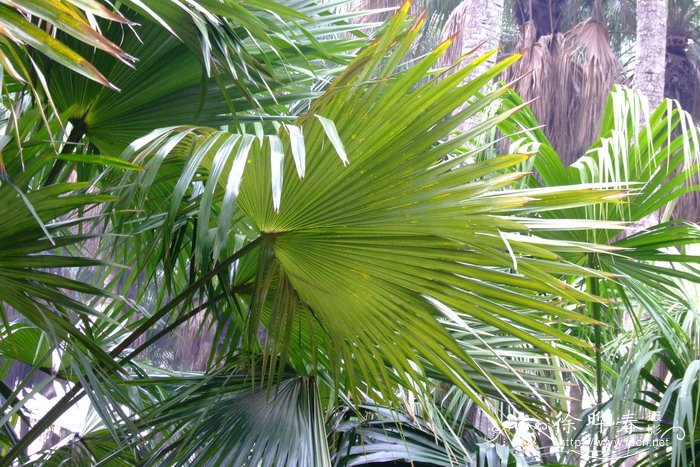美丽蒲葵Livistona jenkinsiana
中文名(Chinese Name):美丽蒲葵
学名(Scientific Name):Livistona jenkinsiana Griff.
英文名(English Common Name):
别名(Chinese Common Name):香蒲葵
异名(Synonym):Livistona speciosa Kurz Livistona jenkinsii Griff. ex Mart. Saribus speciosus (Kurz) Kuntze Saribus jenkensii (Griff.) Kuntze
科属(Family & Genus):棕榈科(Palmae)蒲葵属
形态特征(Description):乔木状,粗壮,高15-20米或更高,树干直径30-40厘米或更粗。叶大型,叶片外观为3/4圆形或近圆形,叶面深绿色,背面稍苍白,有一个大的不分裂的中心部分,周围分裂成多数向先端渐狭的裂片,每裂片先端具短2裂,小裂片长3-5厘米,先端不下垂,中央的裂片从叶柄顶部的戟突至裂片先端长1-11.2米,宽3-4.5厘米,裂片较短,其余裂片较长;叶柄粗壮,长1.5-2米,整个叶柄两侧特别在下部具强壮的稍扁平的黑褐色下弯的刺,刺的顶端稍镰刀状向上弯,下部的最大的刺长2厘米,基部宽达1厘米。花序腋生,粗壮,长达1.3米,具4-6个分枝花序,长30-50厘米;每分枝花序从各自的佛焰苞口伸出,具2-3次分枝;小花枝长10-15厘米,花着生于小花枝上的螺旋状排列的小瘤突上;花5-6朵(花枝下部)或2-3朵(上部)聚生,黄绿色,未开放时为阔卵形,急尖,长约2毫米;花萼约裂至中部而成3个宽的半卵形近急尖的裂片,边缘薄膜质近透明;花冠2倍长于花萼,约裂至中部成3个正三角形急尖的裂片;雄蕊6枚,在基部合生成杯状,部分与花冠基部粘合,其上部分离部分具宽的基部并突变狭成钻状稍细长的尖头,花药近圆形;子房的心皮上面具深雕纹。果实倒卵球形,顶部圆形,基部变狭,长2.3-2.5厘米,直径1.5-2厘米,外果皮薄,浅蓝色。种子椭圆形或近卵球形,长1.5-1.8厘米,直径1-1.4厘米,胚位于种脊对面的中部偏下。花果期10月。
分布(Distribution):产云南南部。缅甸也有。
用途(Use):本种在云南南部村寨常见栽培,是很好的绿化树种。果实可食。
引自中国植物志英文版:FOC Vol. 23 Page 147
Livistona jenkinsiana Griffith, Calcutta J. Nat. Hist. 5: 334. 1845.
美丽蒲葵 mei li pu kui| Arecaceae | Livistona
Latania jenkinsiana (Griffith) Devansaye; Livistona fengkaiensis X. W. Wei & M. Y. Xiao; L. moluccana H. Wendland; L. speciosa Kurz; Saribus jenkinsianus (Griffith) Kuntze ["jenkensii"]; S. speciosus (Kurz) Kuntze.
Stems to 25 m tall, to 30 cm in diam., rough with leaf scars. Leaves palmate; petioles 1.3-2 m, with brown recurved spines along margins, decreasing in density toward distal end; hastula to 3 cm; blades almost circular in outline, 1.5-2 m wide, grayish green abaxially, green adaxially, regularly divided to ca. halfway or more into 70-100 segments, these briefly split and erect at apices. Inflorescences to 2 m, branched to 3 orders, with 3-6 partial inflorescences; rachillae 10-30 cm; flowers bisexual, solitary or borne in clusters of 2-6, yellowish, 2.5-4 mm. Fruits bluish, globose to ellipsoid or pear-shaped, to 3.5 × 2.5 cm.
Forests and open areas, commonly planted in villages or other disturbed areas; 100-2500 m. Hainan, Yunnan [Bangladesh, Bhutan, India, Malaysia (Peninsular), Myanmar, Thailand].
The leaves are commonly used for thatching and making hats, and small plantations are maintained for leaf harvesting. The seeds are eaten as a substitute for betel nut, and in Hainan the fruits are used medicinally.


(责任编辑:徐晔春)
学名(Scientific Name):Livistona jenkinsiana Griff.
英文名(English Common Name):
别名(Chinese Common Name):香蒲葵
异名(Synonym):Livistona speciosa Kurz Livistona jenkinsii Griff. ex Mart. Saribus speciosus (Kurz) Kuntze Saribus jenkensii (Griff.) Kuntze
科属(Family & Genus):棕榈科(Palmae)蒲葵属
形态特征(Description):乔木状,粗壮,高15-20米或更高,树干直径30-40厘米或更粗。叶大型,叶片外观为3/4圆形或近圆形,叶面深绿色,背面稍苍白,有一个大的不分裂的中心部分,周围分裂成多数向先端渐狭的裂片,每裂片先端具短2裂,小裂片长3-5厘米,先端不下垂,中央的裂片从叶柄顶部的戟突至裂片先端长1-11.2米,宽3-4.5厘米,裂片较短,其余裂片较长;叶柄粗壮,长1.5-2米,整个叶柄两侧特别在下部具强壮的稍扁平的黑褐色下弯的刺,刺的顶端稍镰刀状向上弯,下部的最大的刺长2厘米,基部宽达1厘米。花序腋生,粗壮,长达1.3米,具4-6个分枝花序,长30-50厘米;每分枝花序从各自的佛焰苞口伸出,具2-3次分枝;小花枝长10-15厘米,花着生于小花枝上的螺旋状排列的小瘤突上;花5-6朵(花枝下部)或2-3朵(上部)聚生,黄绿色,未开放时为阔卵形,急尖,长约2毫米;花萼约裂至中部而成3个宽的半卵形近急尖的裂片,边缘薄膜质近透明;花冠2倍长于花萼,约裂至中部成3个正三角形急尖的裂片;雄蕊6枚,在基部合生成杯状,部分与花冠基部粘合,其上部分离部分具宽的基部并突变狭成钻状稍细长的尖头,花药近圆形;子房的心皮上面具深雕纹。果实倒卵球形,顶部圆形,基部变狭,长2.3-2.5厘米,直径1.5-2厘米,外果皮薄,浅蓝色。种子椭圆形或近卵球形,长1.5-1.8厘米,直径1-1.4厘米,胚位于种脊对面的中部偏下。花果期10月。
分布(Distribution):产云南南部。缅甸也有。
用途(Use):本种在云南南部村寨常见栽培,是很好的绿化树种。果实可食。
引自中国植物志英文版:FOC Vol. 23 Page 147
Livistona jenkinsiana Griffith, Calcutta J. Nat. Hist. 5: 334. 1845.
美丽蒲葵 mei li pu kui| Arecaceae | Livistona
Latania jenkinsiana (Griffith) Devansaye; Livistona fengkaiensis X. W. Wei & M. Y. Xiao; L. moluccana H. Wendland; L. speciosa Kurz; Saribus jenkinsianus (Griffith) Kuntze ["jenkensii"]; S. speciosus (Kurz) Kuntze.
Stems to 25 m tall, to 30 cm in diam., rough with leaf scars. Leaves palmate; petioles 1.3-2 m, with brown recurved spines along margins, decreasing in density toward distal end; hastula to 3 cm; blades almost circular in outline, 1.5-2 m wide, grayish green abaxially, green adaxially, regularly divided to ca. halfway or more into 70-100 segments, these briefly split and erect at apices. Inflorescences to 2 m, branched to 3 orders, with 3-6 partial inflorescences; rachillae 10-30 cm; flowers bisexual, solitary or borne in clusters of 2-6, yellowish, 2.5-4 mm. Fruits bluish, globose to ellipsoid or pear-shaped, to 3.5 × 2.5 cm.
Forests and open areas, commonly planted in villages or other disturbed areas; 100-2500 m. Hainan, Yunnan [Bangladesh, Bhutan, India, Malaysia (Peninsular), Myanmar, Thailand].
The leaves are commonly used for thatching and making hats, and small plantations are maintained for leaf harvesting. The seeds are eaten as a substitute for betel nut, and in Hainan the fruits are used medicinally.
(责任编辑:徐晔春)
踩一下[1]

顶一下[2]